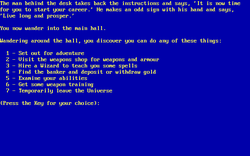Eamon-PC

Eamon-PC is a version of Eamon adapted by John Nelson to run on a PC platform. Nelson based Eamon-PC on Eamon Master 2 and converted several adventures to the system, starting with his The Caves of Mondamen; he also wrote a dungeon designer for the system, as well as a utility for converting Apple adventures to PC. Nelson announced the release of Eamon-PC in the January 1987 issue of the club newsletter.
Adventures
Nelson converted 21 adventures to Eamon-PC:
| Number | Title | Author |
|---|---|---|
| 1 | The Beginners Cave | Donald Brown |
| 2 | The Lair of the Minotaur | Donald Brown |
| 3 | The Cave of the Mind | Jim Jacobson and Red Varnum |
| 4 | The Zyphur Riverventure | Jim Jacobson |
| 5 | Castle of Doom | Donald Brown |
| 7 | The Devil's Tomb | Jim Jacobson |
| 8 | The Abductor's Quarters | Jim Jacobson |
| 9 | Assault on the Clone Master | Donald Brown |
| 10 | The Magic Kingdom | David Cook |
| 11 | The Tomb of Molinar | Donald Brown |
| 12 | The Quest for Trezore | Jim Jacobson |
| 15 | Heroes Castle | John Nelson |
| 16 | The Caves of Mondamen | John Nelson |
| 19 | Death Trap | John Nelson |
| 20 | The Black Death | John Nelson |
| 21 | The Quest for Marron | John Nelson |
| 33 | The Orb of Polaris | John Nelson |
| 77 | Temple of the Trolls | John Nelson |
| 78 | The Prince's Tavern | Bob Davis |
| 100 | Sorceror's Spire | John Nelson |
| 120 | Orb of My Life | John Nelson |
PC Eamon Museum
Eamon Deluxe developer Frank Black included Nelson's port in his "PC Eamon Museum", a collection of various PC-based Eamon projects. Black made minor adjustments to Nelson's files, which he described in his notes:
Oddly enough, John Nelson contacted me (for the first time ever) just days after I had started the PC Eamon Museum project and possibly just hours after I had added his system into it. I quickly scripted and sent to him a fresh beta installer to check out and he seemed pretty excited about it. He also informed me that he had a version that was somewhat newer, had a few more adventures converted, and also that he was interested in reviving the development of it. I offered to pull his exhibit out of the Museum at that point, but he didn't seem to mind its inclusion and said he was going to send me the later version from his archives.
We then exchanged a few more messages discussing different programming platforms and ways to convert source files before, just as oddly as John had appeared, he "pulled an Eamon" (as I have coined the term) and apparently disappeared off of the face of the Earth again. The lat message I received from him was dated 03/08/2012. I waited a month to be fair and then decided to go ahead and finish up what was now the last unfinished area of the Museum, using the Eamon CD version of "PC Eamon" as my source material.
While the initial appearance and game play may seem just as dated as the Gilbert or Walker exhibits, John's PC Eamon ports are actually very nicely coded and debugged. I made the minimal modifications to it that were needed for compatibility with the Museum setup and, unlike the Gilbert and Walker archives before it, I didn't save an untouched copy of the source since it is already easily available via the Eamon CD.
All of the unneeded QB45-sourced copied of John's programs were deleted, as well as the similarly unneeded executable versions and various utilities programs that switched the program names of the three formats around. Having reduced the bulkiness of the archive quite a bit, I decided to drop a pre-made character into each adventure directory so that visitors may explore this section of the Museum at their leisure.
As a final touch, I also reset the ultra bright default colors in each directory to bit a bit less harsh on the eyes and, in my opinion, better reflect this particular Eamon system as well as the time period in which it was created.
While I confess that I didn't thoroughly test each program due to lack of time, everything I did test appeared to be working fine and nothing crashed on me during my explorations. All in all, John's museum exhibit is very well done and, while not being a huge leap in progression from its classic Apple II predecessor, it's definitely one of the more advanced entries into the wide and anomalous world of Eamon gaming platforms. It also pleasantly retains that same signature Nelson style that many will recognize from his earlier Eamon work.
Gallery
-
The v. 2.81 main menu
-
The v. 2.93 main menu in Black's "Museum"
-
The intro to Nelson's Sorceror's Spire
-
Adventure interface in The Lair of the Minotaur
External links
| |||||||||||||||||||||||



